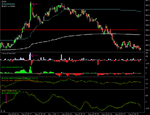I can't challenge your well-written, clear and succinct explanation (for which I thank you), but what I cannot give credence to is how a retail trader can realistically identify the fakers from the shakers.
With the limited resources at your disposal, I struggle to get past the supposition that any success you obtain with this is anything but luck and playing the odds.
If I'm wrong, I salute you !
meh you don't really know what will work and what won't, an understanding of time and sales an order flow will help your odds.
Don't forget though, that this is just scalping a few tick or points here or there.
And access to DOM can tell you what is support and resistance ( support has lots of buy limits and vice versa).
The real gains are made by holding for a few hours and not a few seconds, identifying if it will be a trend day or not by realising patterns on $trin or $tick in the opening minutes or hours, after that you can just hold on all day.
well for example $tick in the first hour of ES pushes +1000 5 times lets say....price budges a little upwards...then $tick hits -800 and price moves down a lot you can tell the bears are in control, and by looking at advanced decline line,$trin and other internals you can see what the sentiment of the market is- even if a negative tick pushes price more than a positive one there is no point holding short whenever other internals suggest bulls are in control.....
edit: by the by the whole scalp breakouts thing is ok if you have reduced comissions or a CME or CBOT seat or something like that, but for the majority paying 4-5 RT you have to look for places where pirce is gonna bounce lmore than 1 or 2 ticks, more like a point, for example trading a retracement of a breakout, you can tell whether price is actually going to bounce by checking time and sales during the breakout (if it's resistance) you will see a lot of asks being hit because of stop losses, after this you can place a buy limit at previous resistance and trade the bounce for a decent scalp ( stop loss will be one tick below previous resistance)

